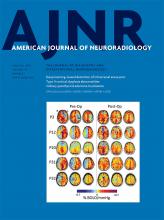Abstract
BACKGROUND AND PURPOSE: The validity of radiology peer review requires an unbiased assessment of studies in an environment that values the process. We assessed radiologists' behavior reviewing colleagues' reports. We hypothesized that when a radiologist receives a discrepant peer review, he is more likely to submit a discrepant review about another radiologist.
MATERIALS AND METHODS: We analyzed the anonymous peer review submissions of 13 neuroradiologists in semimonthly blocks of time from 2016 to 2018. We defined a discrepant review as any one of the following: 1) detection miss, clinically significant; 2) detection miss, clinically not significant; 3) interpretation miss, clinically significant; or 4) interpretation miss, clinically not significant. We used random-effects Poisson regression analysis to determine whether a neuroradiologist was more likely to submit a discrepant report during the semimonthly block in which he or she received one versus the semimonthly block thereafter.
RESULTS: Four hundred sixty-eight discrepant peer review reports were submitted; 161 were submitted in the same semimonthly block of receipt of a discrepant report and 325 were not. Receiving a discrepant report had a positive effect on submitting discrepant reports: an expected relative increase of 14% (95% CI, 8%–21%). Notably, receiving a clinically not significant discrepant report (coefficient = 0.13; 95% CI, 0.05–0.22) significantly and positively correlated with submitting a discrepant report within the same time block, but this was not true of clinically significant reports.
CONCLUSIONS: The receipt of a clinically not significant discrepant report leads to a greater likelihood of submitting a discrepant report. The motivation for such an increase should be explored for potential bias.
- © 2019 by American Journal of Neuroradiology







